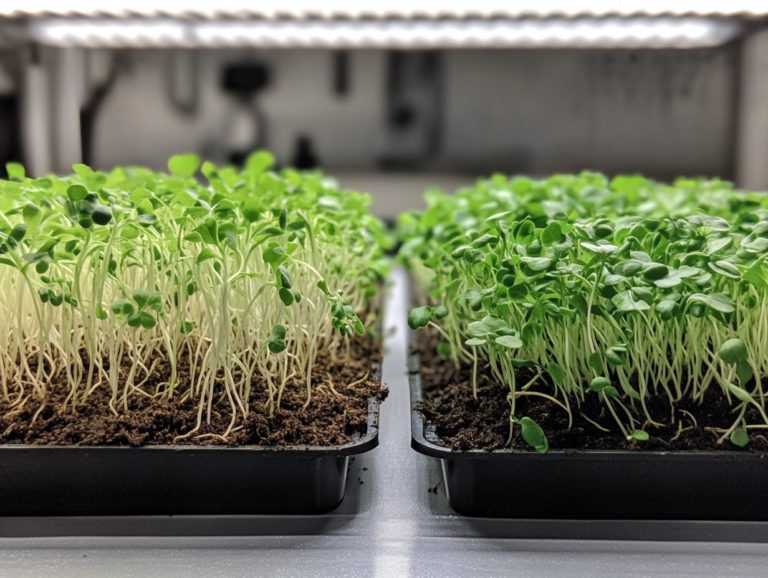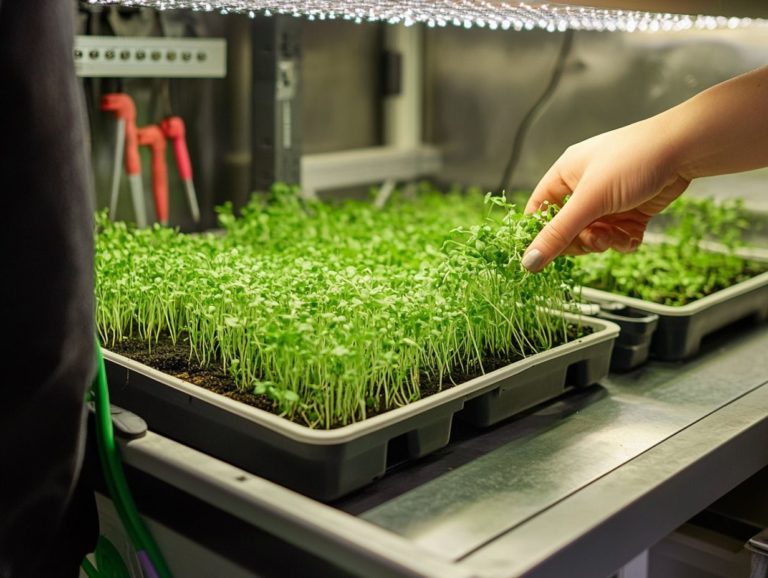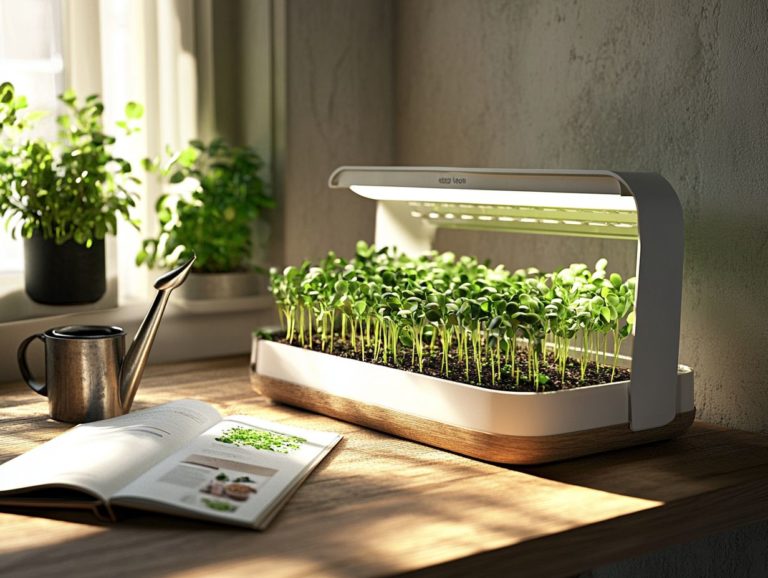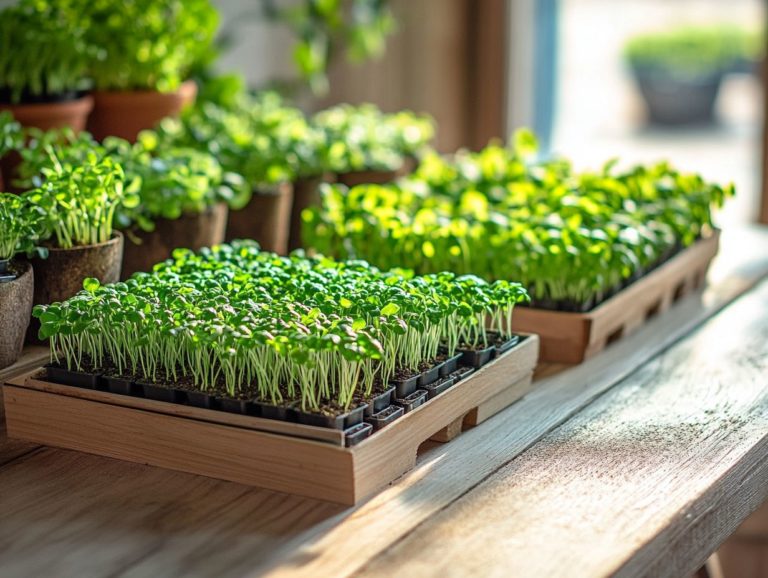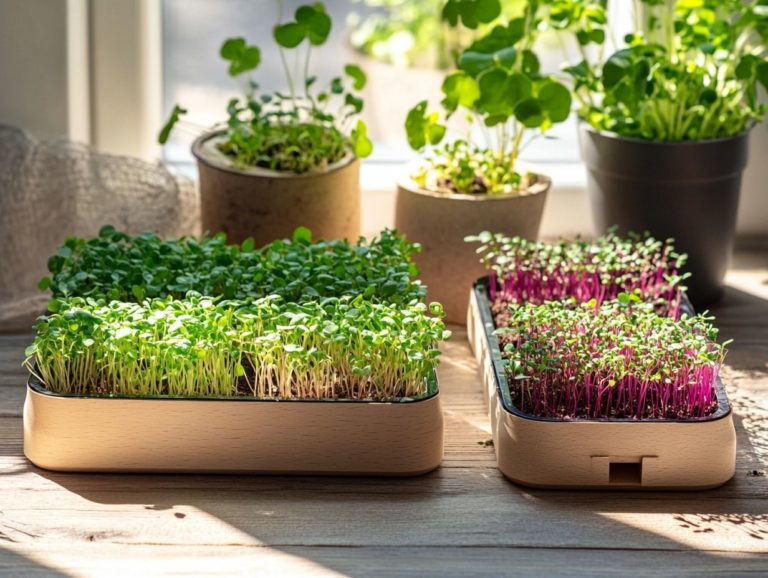5 Best LED Lights for Microgreens
In the realm of indoor gardening, microgreens have become a standout favorite, and it’s easy to see why. These little powerhouses burst with nutrients and flourish under the right lighting conditions. LED options are now the go-to choice for growers like you.
This article delves into the vital role that light plays in nurturing microgreens. It provides you with a comprehensive guide to selecting the best affordable LED lights for optimal growth. From top-rated products to innovative DIY setups, you ll find everything you need to ensure your microgreens thrive.
Get ready to transform your indoor gardening into a vibrant success!
Contents
- Essential Tips for Choosing LED Lights:
- 1. Understanding the Importance of Light for Microgreens
- 2. Factors to Consider When Choosing LED Lights for Microgreens
- 3. Top 5 LED Lights for Microgreens
- 4. DIY LED Light Setups for Microgreens
- What Are the Benefits of Creating a DIY LED Light Setup?
- What Materials and Tools Are Needed for a DIY LED Light Setup?
- Step-by-Step Guide to Creating a DIY LED Light Setup for Microgreens
- Tips and Tricks for Maintaining a DIY LED Light Setup for Microgreens
- How Can One Upgrade Their DIY LED Light Setup for Better Results?
- Factors to Consider When Making a Decision
- Final Thoughts and Recommendations
- Frequently Asked Questions
- What are the top 5 best LED lights for microgreens?
- What features should I look for when choosing the best LED lights for microgreens?
- Are LED lights better for microgreens than traditional fluorescent or incandescent lights?
- How do LED lights benefit the growth of microgreens?
- Can I use any LED light for growing microgreens?
- How should I position my LED lights for optimal growth of my microgreens?
Essential Tips for Choosing LED Lights:

- Understand the role of LED lights in the growth and development of microgreens.
- Consider factors such as color spectrum, intensity, and coverage when choosing LED lights for microgreens.
- Explore the top 5 highly rated LED lights for microgreens based on features, price, and customer reviews; these options cater to different types of microgreens.
1. Understanding the Importance of Light for Microgreens
Light plays an essential role in the successful growth of your microgreens. It directly influences their ability to produce food using light, nutrient absorption, and overall health. By understanding the importance of light, you can significantly enhance the growth rates of varieties like Broccoli and Basil microgreens.
Different microgreens have unique light requirements; some thrive under full-spectrum grow lamps that closely mimic natural sunlight. This replication is particularly advantageous for cultivating crops indoors or in areas with limited indirect sunlight.
The rise of LED grow lights has become popular due to their energy efficiency and longer lifespan compared to traditional fluorescent options. These systems maintain ideal light intensity while generating minimal heat, which can negatively impact growth rates.
By optimizing light conditions, you can ensure that each microgreen variety reaches its full potential, transforming your growing experience into a flourishing success with the right microgreens grow lights.
2. Factors to Consider When Choosing LED Lights for Microgreens
Choosing the right LED lights for your microgreens is crucial for maximizing growth and ensuring your plants flourish. Consider light color temperature, ease of installation, and affordability when making your decision as a home microgreen grower.
The specific type of microgreens you re cultivating should guide your lighting choices. Different varieties thrive under varied light spectrum conditions. For instance, leafy greens typically prefer cooler light temperatures, while vibrant colors benefit from broader spectrums to optimize their ability to produce food using light.
Energy efficiency is another critical factor, especially among affordable LED options. It can substantially impact your long-term operational costs compared to pricier commercial-grade fixtures. Proper installation of your lighting setup can dramatically affect your microgreens’ overall production.
Even the most powerful lights won t perform if they aren t positioned correctly. A well-planned layout that considers light distribution ensures uniform growth and healthier plants, particularly for green-leaf microgreens and red-leafed microgreens.
Select the right lights today and watch your microgreens thrive!
3. Top 5 LED Lights for Microgreens
Regarding optimizing your microgreens production, selecting the right LED lights is essential. The top five highly rated LED lights available on platforms like Amazon and from reputable manufacturers possess unique features tailored specifically to meet the needs of home microgreen growers.
These lights are designed to enhance growth rates and maximize flavor profiles. They ensure your delicate seedlings receive the precise light spectrum needed for optimal development.
Each option on this curated list has been evaluated for its performance, energy efficiency, and user-friendliness, making it easy for novice gardeners to dive in. Customer reviews offer a glimpse into the real-world effectiveness of each product, showcasing pros and cons from individual experiences.
By exploring these top choices, you can discover the perfect lighting solution that strikes a balance between quality and affordability, empowering you to cultivate your microgreens successfully with an understanding of the importance of light quality for microgreens.
What Makes These LED Lights Stand Out?
The standout features of these LED grow lights for microgreens truly elevate your growing experience. You ll appreciate their energy efficiency, adaptability to various growing conditions, and the ability to deliver full-spectrum light that encourages robust growth across a range of microgreens, whether green-leafed or red-leafed.
With a lumens output specifically designed to meet the precise light needs of seedlings, these lights guarantee that each plant gets the optimal brightness for photosynthesis essential for healthy development. The spectrum range from these advanced LED systems mimics natural sunlight, boosting chlorophyll production and promoting vibrant colors in your microgreens.
Their impressive longevity means you won t have to worry about frequent replacements, making them a cost-effective choice for you as a grower. When you compare these commercial options with DIY setups or those found at box stores, it s clear that the specialized features of these lights lead to superior growth outcomes and enhanced yields over time.
How Do They Compare in Terms of Price and Features?
When you re comparing LED lights for your microgreens, it s crucial to evaluate not just the price but also the features they offer. A thorough price comparison will reveal that some budget-friendly LED lights provide exceptional value without skimping on the essential functionalities needed for optimal growth.
For example, one model may be easy on your wallet while incorporating advanced spectrum technologies specifically designed to support rapid germination. Alternatively, there might be a compact option perfect for tight spaces that still delivers impressive energy efficiency.
Microgreens like basil and radish thrive particularly well under lights that allow for adjustable light intensity. Balancing your budget with effective lighting is essential, especially when you want to promote growth, vibrant color, and nutrition in your greens.
By understanding what each light offers, you ll empower yourself to make informed decisions that maximize your yield while keeping costs in check.
What Are the Customer Reviews for Each LED Light?
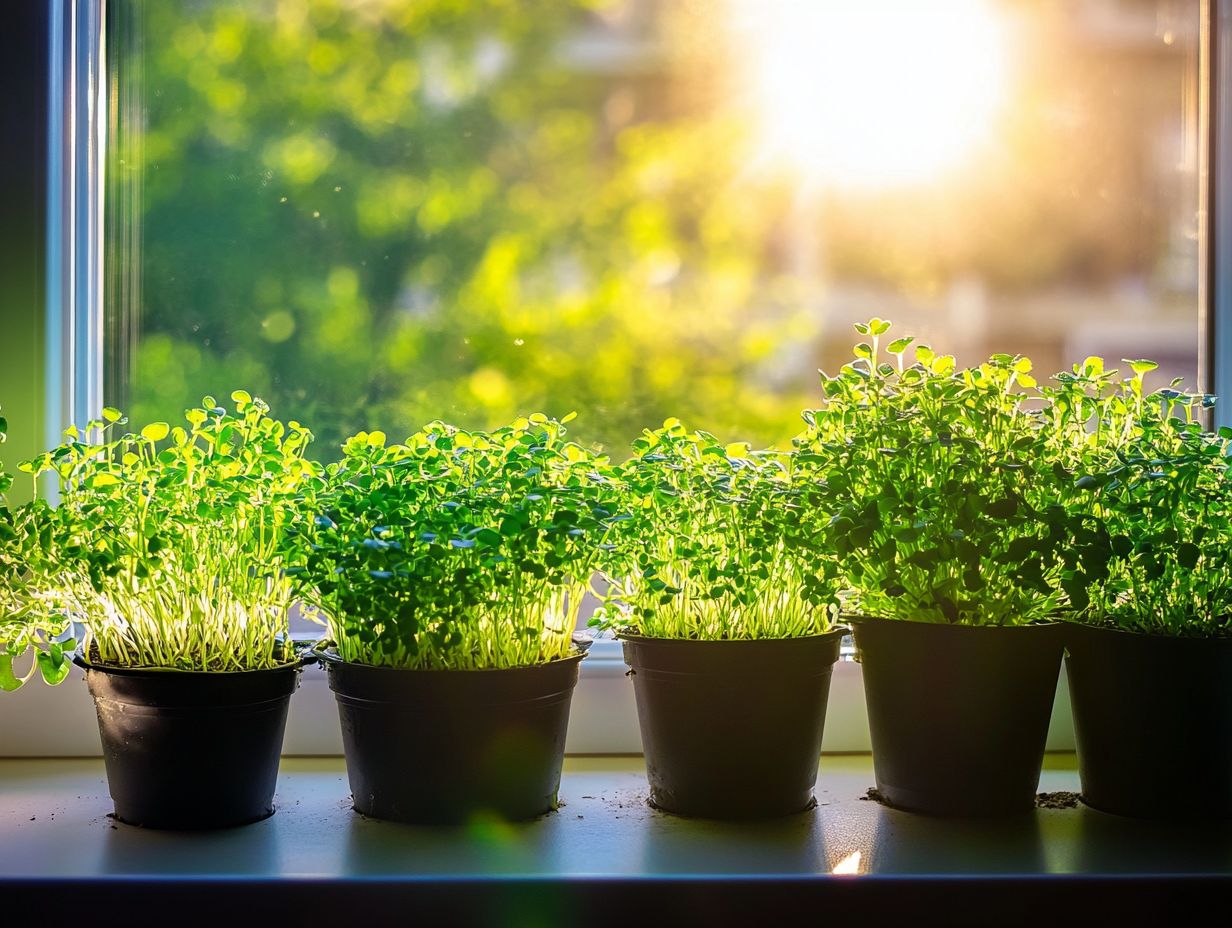
Customer reviews reveal how well each LED light performs, offering valuable insights into user experiences and satisfaction levels across various models and brands. These evaluations provide you the ability to discern which products deliver optimal growth, energy efficiency, and adaptability in different environments.
Reviews may spotlight important factors such as light intensity, spectrum quality, and heat output. While some users enthusiastically share their stories of impressive yield increases and reduced electricity costs, others might express concerns regarding durability or customer support.
By understanding these factors, you can choose the perfect lighting solution for your microgreens, ensuring that your investment effectively fosters successful microgreens production.
Which LED Light Is Best for Different Types of Microgreens?
Different types of microgreens, like Broccoli and Basil, have unique light requirements. It s crucial to select the right LED light that caters to these varying needs for optimal growth.
For instance, Broccoli microgreens thrive under full-spectrum LED lights that offer a balanced mix of cool and warm white wavelengths. This promotes robust growth in a relatively short amount of time. On the other hand, Basil, with its lush green leaves, flourishes under lights that emphasize the blue spectrum during its early stages to ensure strong seedlings. To optimize your indoor gardening, consider following the best practices for indoor microgreens.
If you re cultivating red-leaf varieties, such as Red Amaranth, consider LED setups that enhance the red spectrum. This helps plants make food from sunlight and intensifies the vibrant color of the leaves. Grasping these specific spectrum needs and growth rates can significantly boost both your yield and quality.
How Can One Optimize the Use of LED Lights for Microgreens?
To achieve the best results in microgreens production, you ll want to optimize your use of LED lights through strategic installation, careful light duration, and adjusting intensity based on the specific growth stage and needs of your microgreens. This thoughtful approach ensures that your plants receive the adequate light they need for optimal growth and flavor development.
When installing LED lights, aim for an ideal height of around 12 to 24 inches above your microgreens. This distance prevents light burn and ensures your plants get enough light. For more insights, consider understanding light needs for microgreens. During the germination phase, a light duration of 12-14 hours a day works wonders, whereas mature microgreens thrive with an extended exposure of up to 16 hours.
It s just as important to monitor environmental factors like temperature and humidity, as these can influence your light requirements. Be prepared to adjust intensity or duration accordingly. Setting up a timer for automated light cycles and avoiding common pitfalls like placing lights too close or opting for those that are too dim can significantly boost your overall yield.
4. DIY LED Light Setups for Microgreens
Creating a DIY LED light setup for your microgreens can be an incredibly rewarding venture! It allows you to tailor your lighting solutions to meet specific needs while keeping your budget intact with affordable LED lights.
Not only does this approach help you save money, but it also opens up a world of customization opportunities based on your preferences and the space you have available. With a sprinkle of creativity, you can design a lighting arrangement that boosts growth potential and enhances the overall aesthetic of your growing area.
To get started on this project, you’ll need a few materials, including:
- LED strips: These provide the main light source.
- Hanging fixtures: Used to mount the lights securely.
- Power supplies: Essential for powering the LED lights.
- Mounting hardware: Needed for securing everything in place.
The installation process is straightforward: measure your desired area, secure the lights to frames or shelves, and ensure you have adequate light coverage. Your configurations can range from simple overhead lighting to more intricate setups using adjustable racks, perfectly suited for various microgreens and ensuring they receive the optimal light for healthy growth.
What Are the Benefits of Creating a DIY LED Light Setup?
Creating a DIY LED light setup for your microgreens brings a wealth of benefits, including cost efficiency, design flexibility, and the ability to precisely tailor light conditions to meet the unique needs of various microgreen varieties.
This level of customization is particularly advantageous if you’re working with limited growing space or have specific lighting preferences. For example, consider a DIY enthusiast who crafted a compact LED system with adjustable panels to cultivate high-yield varieties right in their small apartment kitchen, significantly boosting growth rates.
By choosing LED bulbs with varying spectrums, you can promote specific growth phases like enhancing red light for flowering or blue light for leafy growth. These projects not only showcase the practical benefits of DIY LED setups but also unveil transformative results, leading to vibrant, thriving microgreens that cater to your personal tastes and requirements. For optimal results, consider following the 5 best practices for harvesting microgreens.
What Materials and Tools Are Needed for a DIY LED Light Setup?
To create an effective DIY LED light setup for your microgreens, you’ll need some essential materials: LED strips, power supplies, mounting hardware, and a few handy tools like a drill and screwdriver for installation.
Choosing the right LED lights is paramount. Aim for full-spectrum options with a color temperature between 5000K and 6500K to encourage robust growth. For wattage, aim for about 10 to 30 watts per square foot for strong growth. Additionally, consider the top grow lights for microgreens in 2024 to ensure optimal lighting. Select power supplies that match the voltage and current requirements of your chosen LED strips to avoid electrical mishaps.
Sourcing these items can be budget-friendly. Check your local hardware stores, browse online marketplaces for great deals, or consider second-hand options, which often provide quality materials at a fraction of the cost.
Step-by-Step Guide to Creating a DIY LED Light Setup for Microgreens
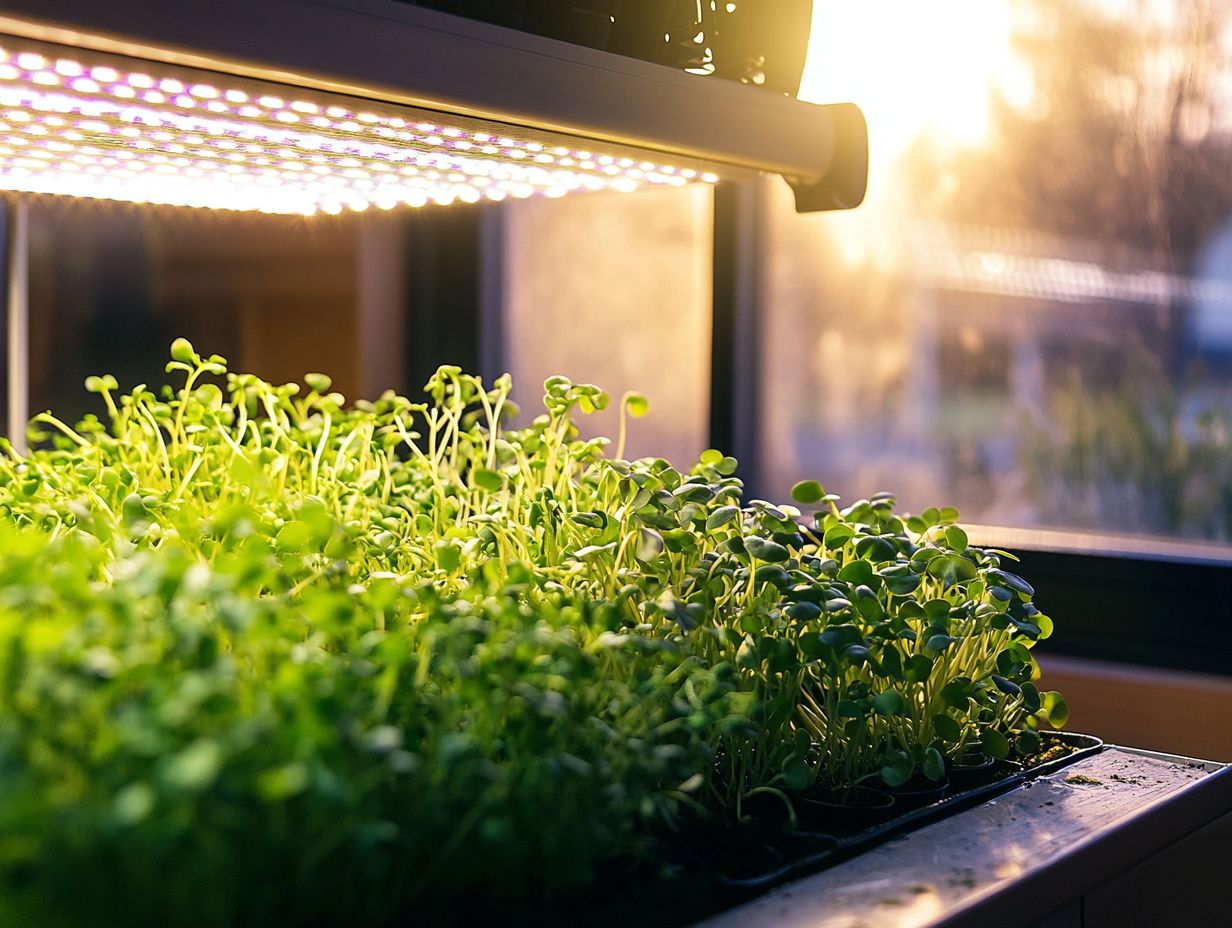
This step-by-step guide will lead you through the art of crafting a DIY LED light setup for microgreens, emphasizing practical installation techniques and creating the perfect lighting conditions for vibrant plant growth.
Before you dive into the installation process, it s crucial to plan your layout. Consider the available space and the specific types of microgreens you’re intending to grow. Different varieties have unique lighting requirements. This preparation includes measuring dimensions and figuring out how many growing trays will comfortably fit beneath the lights.
With your plan in place, gather all the necessary materials, such as adjustable light fixtures and high-quality LED bulbs.
Once you ve secured the lights at the right heights, make minor adjustments to ensure even light distribution no part of those microgreen trays should be left in the dark. Periodically check for any light malfunctions or signs of uneven growth. If you notice issues, troubleshoot by repositioning the lights or tweaking the timer settings to create that ideal growing environment.
Tips and Tricks for Maintaining a DIY LED Light Setup for Microgreens
Maintaining a DIY LED light setup for your microgreens is essential for fostering consistent and effective growth. Focus on regular checks, proper cleaning, and monitoring light intensity to ensure that your plants thrive.
Conduct regular inspections at least once a week to catch any issues before they escalate. This ensures that your lights are functioning at their best. Clean the LED fixtures every two weeks to eliminate dirt and other contaminants that could diminish light output.
Use a light meter to check if you need to adjust light levels for your microgreens. By implementing these maintenance practices, you enhance the overall health of your plants and extend the lifespan of your lighting system. Additionally, understanding the right light spectrum for microgreens can maximize your return on your investment.
How Can One Upgrade Their DIY LED Light Setup for Better Results?
Upgrading your DIY LED light setup for microgreens can genuinely elevate your growth results. Try adding higher-quality LEDs, adjusting your layout, or incorporating reflective materials to optimize light efficiency.
Swap out outdated lighting fixtures for highly rated LED alternatives that deliver the ideal spectrum required for thriving microgreens. To learn more about achieving the perfect light conditions for microgreens, adjust the height or angle of the lights to ensure that each seedling bathes in uniform illumination, promoting robust development.
Timers simplify the management of light cycles, ensuring consistency in growth. These practical upgrades not only enhance the effectiveness of your lighting setup but also lead to healthier plants. With these upgrades, expect an abundant harvest that boosts your profits!
Factors to Consider When Making a Decision
When deciding which LED light to purchase for your microgreens, it s important to consider several critical factors, including the specific light needs of the various microgreens, overall energy use, and your budget constraints to achieve optimal results.
You ll want to evaluate aspects like light intensity, as this can significantly influence photosynthesis the process by which plants convert light into energy and growth speed. Balancing quality and affordability is essential for maintaining sustainable gardening practices. User reviews provide valuable insights into real-world experiences with specific lights and reveal how they perform in different conditions.
By closely examining these elements, you can select an LED light that not only fosters robust growth and enhances flavor profiles but also contributes to the successful cultivation of vibrant, healthy microgreens. For more tips, check out how to use grow lights for microgreens.
Final Thoughts and Recommendations
Investing in the right LED lights for your microgreens can yield impressive growth rates and healthier plants. Your decisions should be anchored in a thoughtful analysis of features, customer reviews, and overall effectiveness across various growing conditions.
Make sure to evaluate your specific microgreen varieties alongside the unique characteristics of your growing environment. Consider factors like available space, light intensity, and color range to ensure you achieve optimal results. Additionally, exploring the 5 best watering solutions for microgreens can greatly enhance your growing success.
By aligning these elements with your personal goals, whether you’re aiming for a swift harvest or nurturing delicate seedlings, you can make informed choices. Ultimately, the right lighting can turn a simple growing setup into a thriving ecosystem, enhancing your overall experience of cultivating microgreens. For more insights, check out the 5 key factors for successful microgreen growing. Act now to find the perfect LED light and watch your microgreens thrive!
Frequently Asked Questions
What are the top 5 best LED lights for microgreens?
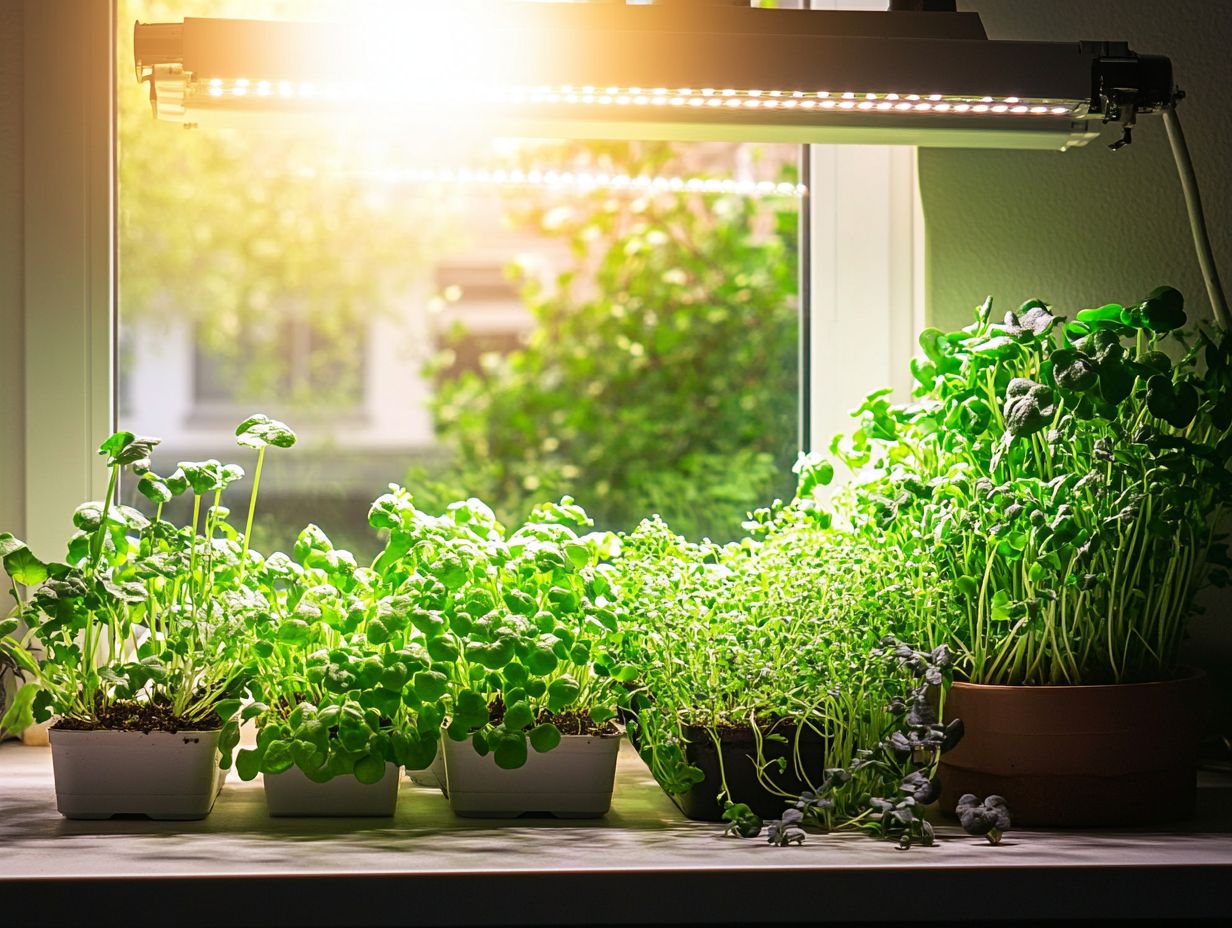
- Spider Farmer SF-2000 LED Grow Light
- Roleadro LED Grow Light
- Phlizon CREE Cob Series 2000W LED Plant Grow Light
- MARS HYDRO TS 1000W LED Grow Light
- VIPARSPECTRA 600W LED Grow Light
What features should I look for when choosing the best LED lights for microgreens?
When looking for the best LED lights for microgreens, consider the light intensity, spectrum, energy efficiency, and coverage area. You’ll want a light with high intensity to support plant growth, a full spectrum for a balanced light source, energy efficiency to save on electricity costs, and enough coverage area for your microgreens.
Are LED lights better for microgreens than traditional fluorescent or incandescent lights?
Yes, LED lights are better for microgreens than traditional fluorescent or incandescent lights. LED lights have a higher light intensity, a full spectrum of light, and are more energy-efficient, making them ideal for growing microgreens indoors. They also have a longer lifespan, which means you won’t have to replace them as often.
How do LED lights benefit the growth of microgreens?
LED lights offer several benefits for the growth of microgreens. They provide a full spectrum of light, which helps with photosynthesis and promotes healthy growth. They also emit less heat than traditional lights, reducing the risk of burning your plants. Additionally, LED lights are energy-efficient and have a longer lifespan, making them a cost-effective option for growing microgreens.
Can I use any LED light for growing microgreens?
While you can technically use any LED light for growing microgreens, it’s recommended to choose one specifically designed for plants. LED grow lights for microgreens have a specific spectrum of light and intensity that supports their growth. Using a standard LED light may not provide the same results and could potentially harm your microgreens.
How should I position my LED lights for optimal growth of my microgreens?
The positioning of your LED lights is important for the optimal growth of your microgreens. It’s recommended to keep the lights 6-8 inches above the top of your plants. As your microgreens grow, you can adjust the height of the lights to maintain this distance. Make sure the lights are evenly distributed over your plants for consistent growth.


